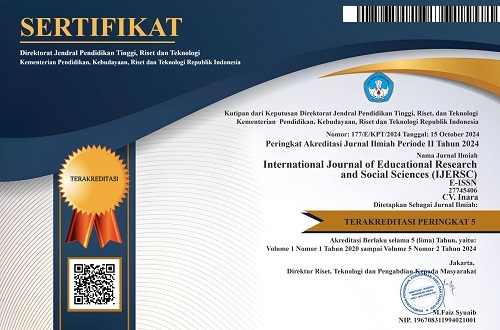The Impact Of Social Media On Social Behavior Children In The City Of Surabaya
DOI:
https://doi.org/10.51601/ijersc.v5i1.781Abstract
The primary issue with this study is how much children who are thought to have a strong interest in character development and child protection use communication media. Children in Surabaya City may be perceived to be influenced by the information and knowledge that the media presents. Qualitative research is the kind that this is. Data is acquired through Three methods: documentation, interviews, and observation. Techniques for data analysis are documented, data is gathered, and analysis is done to give categories meaning. The Snowball Sampling Technique is used to choose and determine research subjects. The snowball sampling technique is a method for selecting and collecting samples within a network or relationship. In Surabaya, a study on children's social and communication media has led researchers to conclude that communication media is necessary for the community, regardless of social class. These days, finding communication media takes a lot of work. The extensive usage of communication media among children and teenagers in the community proves that communication media has also reached all age groups. It cannot be disputed because young people are particularly susceptible to falling prey to the adverse effects of media. Not only may using communication media have significant effects, but it can also have adverse effects that can influence users earlier than youngsters who are quick learners and highly curious. Children's performance can improve if they are given access to unfavorable, unreasonable, or inappropriate things for their age. In this instance, parents' involvement in the supervision process is crucial. Effective communication offers insight into children, obviating the need to do things to adolescents and children, as supportive parents are the primary institution in shaping a child's character, attitude, and behavior.
Downloads
References
I. T. Jadidah, A. Rahayu, H. S. Bella, Julinda, and T. W. Anggraini, “Pengaruh Media Digital terhadap Sosial Budaya pada Anak Usia Sekolah,” J. Multidisipliner Kepalamada, vol. 2, no. 4, pp. 253–268, 2023.
F. Rahmi Putri and Y. Irna Aviani, “Pengaruh Penggunaan Sosial Media Terhadap Tingkat Stress pada Remaja Dimasa Pandemi,” Ranah Res. J. Multidiscip. Res. Dev., vol. 5, no. 2, pp. 110–114, 2023, doi: 10.38035/rrj.v5i2.631.
A. Munif, W. Syahamah, B. A. Damayanti, and R. Y. Fadhilah, “Sosialisasi pada remaja yang Terdampak Sosial Media terhadap Pergaulan Bebas (Studi di MTs Al-Ihsan Desa Banjaragung, Bareng, Jombang),” NAJWA J. Pengabdi. dan Pemberdaya. Masy., vol. 1, no. 1, pp. 9–19, 2023, doi: 10.30762/najwa.v1i1.124.
M. Nur Cahya, W. Ningsih, and A. Lestari, “Dampak Media Sosial terhadap Kesejahteraan Psikologis Remaja: Tinjauan Pengaruh Penggunaan Media Sosial pada Kecemasan dan Depresi Remaja,” J. Sos. Teknol., vol. 3, no. 8, pp. 704–706, 2023, doi: 10.59188/jurnalsostech.v3i8.917.
I. K. Suda, “Domestikasi Kekerasan Simbolik Di Sekolah : Perspektif Sosiologi Pendidikan,” Widyacarya, vol. 3, no. 1, pp. 22–29, 2019.
M. Kurniati and N. Nuryani, “Pengaruh Sosial Media Youtube Terhadap Pemerolehan Bahasa Anak Usia 3-4 Tahun (Studi Pada Anak Speech Delay),” Fon J. Pendidik. Bhs. dan Sastra Indones., vol. 16, no. 1, p. 29, 2020, doi: 10.25134/fjpbsi.v16i1.2494.
C. Afriliani, N. A. Azzura, J. Regina, and B. Sembiring, “Faktor Penyebab dan Dampak dari Kecanduan Pornografi di Kalangan Anak Remaja Terhadap Kehidupan Sosialnya,” Harmony, vol. 8, no. 1, pp. 7–14, 2023, [Online]. Available: http://journal.unnes.ac.id/sju/index.php/harmony.
S. Zeva, I. Rizqiana, D. Novitasari, and F. R. Radita, “Moralitas Generasi Z di Media Sosial: Sebuah Esai,” J. Manejemen Pendidik., vol. 1, no. 2, pp. 1–6, 2023.
N. M. Ghofururrohim, R. N. Wicaksono, and A. R. Faristiana, “Pengaruh Smartphone Terhadap Anak Usia Dini,” Educ. J. Sos. Hum. dan Pendidik., vol. 3, no. 2, pp. 129–146, 2023.
F. Hari Pujayanti, R. Sumiharsono, and E. Triwahyuni, “Pengaruh Metode Game Based Learning terhadap Kemampuan Motorik Kasar dan Kemampuan Sosial Emosional Anak TK,” vol. 4, pp. 1435–1444, 2023, [Online]. Available: http://jurnaledukasia.org.
R. S. Bahtiar et al., “Impact of Social Interaction Among Primary School Students on Learning Performance,” ACM Int. Conf. Proceeding Ser., 2021, doi: 10.1145/3516875.3516909.
D. Y. Suryarini, “New Conceptual In Gamelan Learning: Design Of Virtual Gamelan Learning Media In Indonesia,” vol. 7, no. 1, pp. 247–251, 2022, [Online]. Available: https://erepository.uwks.ac.id/14053/.
Fitriyadi and G. Alam, “Globalisasi Budaya Populer Indonesia (Musik Dangdut) di Kawasan Asia Tenggara,” Padjadjaran J. Int. Relations, vol. 1, no. 3, p. 251, 2020, doi: 10.24198/padjir.v1i3.26196.
A. P. Afdalia and I. Gani, “Dampak pengaruh gadget terhadap interaksi sosial anak usia dini,” J. Bimbing. Penyul. Islam, vol. 10, no. 1, pp. 87–96, 2023.
E. Ingleby, “Research methods in education,” Prof. Dev. Educ., 2012, doi: 10.1080/19415257.2011.643130.
Sugiyono, Metodologi Penelitian R n D. IKAPI, 2010.
Sugiyono, Metode Penelitian Kuantitatif Kualitatif dan R&D. Bandung : CV. Alfabeta, 2011.
Downloads
Published
How to Cite
Issue
Section
License
Copyright (c) 2024 International Journal of Educational Research and Social Sciences (IJERSC)

This work is licensed under a Creative Commons Attribution 4.0 International License.






















